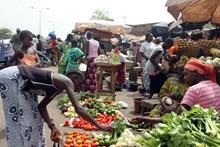
Typical street scene in Santa Ana, El Salvador. (Photo: iStock)
IMF Survey : IMF Secures Concessional Lending for World’s Poorest Countries
October 10, 2013
- IMF members pledge windfall profits to boost longer-term concessional lending
- IMF head, Christine Lagarde, describes development as “historic milepost”
- Agreement is culmination of many years of efforts by IMF
The IMF has secured funding for its concessional loans to the world’s poorest countries with its membership agreeing to contribute more than 90 percent of the windfall profits from the sale of IMF gold to the Poverty Reduction and Growth Trust (PRGT).

Shopping in a market in Mali. The new agreement will provide financial support to the poorest countries for years to come (photo: Habib Kouyate/Newscom)
CONCESSIONAL LENDING
The IMF Managing Director, Christine Lagarde described the commitments as an “historic milepost.”
The newly-secured funding will allow the IMF to lend an average of SDR 1.25 billion (about US$1.9 billion dollars) annually to its low-income members over the longer term, broadly in line with the expected demand for IMF support. The move comes after 151 member countries agreed to pledge their share of windfall profit from the sale of IMF gold to the PRGT.
“We now have the capacity to provide adequate levels of financial support to the poorest countries for years to come,” said Lagarde.
This agreement is the culmination of a multi-year effort first envisaged in the late 1980s to secure adequate resources for the PRGT.
In 2009, the Executive Board of the IMF approved the sale of one-eighth of the IMF’s total holdings of gold to support the Fund’s new income model. With the price of this precious commodity at near record highs, SDR 2.45 billion of the unexpected “windfall gold profits” (from a total SDR 6.85 billion raised), was placed in the IMF’s general reserve.
The IMF’s Executive Board agreed that the windfall profits should be used for the benefit of the Fund’s low-income members, and that the distribution of profits could only take place after members accounting for at least 90 percent of the distribution undertook to make their shares available to the PRGT.
“Despite endorsement of the overall strategy from the Executive Board, securing the necessary contributions from each member was by no means a done deal,” said Robert Powell of the IMF’s Finance department, which spearheaded the effort.
“The pledges had to be obtained one by one. And it took time and perseverance,” he added.
The initiative to win the backing of member countries also involved country teams at the IMF, the Fund’s resident representatives, as well as its Management who lobbied on behalf of the move.


